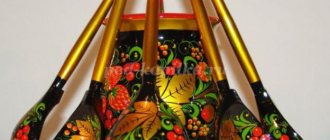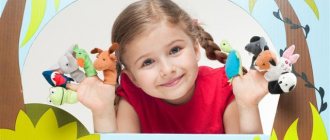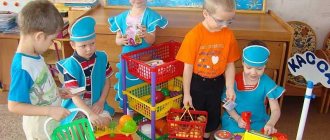Oral folk art as a means of developing children's speech (small forms of folklore, fairy tales).
At preschool age, a qualitatively new stage of speech acquisition begins. The motive for active mastery of the native language is the growing need of the preschooler to learn, tell and influence himself and another person. Speech is included in all types of activities, including cognitive ones. Changes in the tasks facing a preschooler, the emergence of new types of activities, the complexity of communication with adults and peers, the expansion of the circle of life connections and relationships in which key river, leads to intensive development, firstly, of all aspects of speech (vocabulary, sound culture, grammatical structure ), secondly, its forms (contextual and explanatory) and functions (generalizing, communicative, planning, regulating and symbolic).
The development of all aspects of speech is impossible without mastering the sound culture, which forms the basis, the central moment of language acquisition. The sound culture of speech increases the ability of a preschooler to orientate himself in complex relationships of grammatical forms, ensuring the development of the morphological system of the language.
In the development of the sound aspect of speech, the formation of phonematic hearing and correct pronunciation are highlighted. The main thing is the difference between the child and the sound given by him from the sound he himself pronounces. At preschool age, the process of backgroundᶧmatic development is completed. The child hears sounds correctly and speaks. He no longer recognizes incorrectly pronounced words. The preschooler develops subtleᶧ and differentiatedᶧ sound images of words and individual sounds.
In the development of a preschooler's vocabulary, significant changes in quality and quantity are observed. In the child’s speech there are not only more words, but, what is very important, their meanings are developing. The baby learns words early, but the meaning contained in them is learned gradually. With age, the nature of the generalizations contained in the word changes. Let us recall that at the end of the first - beginning of the second year of life, the word designates one specific object, corresponding to its sensory image. By the end of the second year of life, the word denotes a group of homogeneous objects (“cup” means differentᶧ cups). At 3−3.5 years, the word combines several groups of homogeneous objects: furniture, toys, clothes. At 4-5 years old, the child uses words that contain the summary of previous generalizations. For example, the word “plant” includes groups such as berries, trees, fruits and so on. But such a generalization is still based on the most striking features that the child has learned in his own practical activities. That is, the generalization contained in the word remains concrete and visual. Behind every word of a preschooler there is an idea about a specific object or situation. An older preschooler, using words denoting abstract categories, explains them based on his experience of interacting with others. For example, a greedy person is one who does not share toys, a kind person is one who does not share toys. Moral concepts are tied to a specific situation. Therefore, in the speech of a preschooler, words predominate that denote specific objects that are as close as possible to the child himself, objects with which he constantly acts.
Development of children's speech through oral folk art article on speech development (junior group)
Development of children's speech through oral folk art
Currently, along with the search for modern models of education, the best examples of folk pedagogy are being revived. I believe that folklore is one of its most effective and vibrant means, fraught with enormous didactic opportunities. Also K.D. Ushinsky emphasized that “the wisdom of ancestors is a mirror for descendants,” and therefore advocated public education, because it is a living example in the process of moral development.
The problem of developing children's speech through small forms of folklore today is of particular importance. At an early age, it is very important to accelerate the “birth” of the child’s first conscious words. Small forms of folklore help to increase the stock, in which one’s attention is drawn to objects, animals, and people. The sonority, rhythm, melodiousness, and entertaining nature of folk works attracts children’s attention, makes them want to repeat them and remember them, which in turn contributes to the development of spoken language.”
She began her work by studying methodological literature. The following manuals seemed most interesting to me: L.N. Pavlova “Early childhood: development of speech and thinking”; K. Belaya “Activities with kids in kindergarten.” The work was based on the scientific achievements of A.P. Usova “Russian folk art in kindergarten”, E.A. Flerina “Aesthetic education of preschool children.” The articles of Candidate of Psychological Sciences L.N. helped us select the most successful methods of influencing children. Pavlova “Folklore for kids.” In my activities I rely on the comprehensive lessons of T.M. Bondarenko, since they include a large content of folklore material. Children's folklore is a vast area of oral folk art. This is a whole world - bright, joyful, filled with vitality and beauty. For centuries, people selected and preserved, passed on from mouth to mouth these small masterpieces, complete
With the help of small forms of folklore, it is possible to solve almost all problems in the methodology of speech development, and along with the basic methods and techniques of speech development of preschoolers, this rich material of verbal creativity of the people can and should be used.” These are the first works of art that a child hears. They are varied in content: lullabies are soothing, funny ones are pleasing, they convey love for the child and care for him. Getting to know folk nursery rhymes broadens children's horizons, enriches their feelings and speech, and shapes their attitude towards the world around them.
The development of children's speech through folklore works, of course, does not manifest itself. The teacher plays an important role in this, skillfully guiding this process. Therefore, in my work with children, I set myself
goal: to use works of Russian folklore as an opportunity to develop the speech of young children; to make children's lives interesting and meaningful, to fill it with vivid impressions, the joy of creativity, and the ability to know themselves and the world around them.
Tasks:
- mastering spoken language;
- expansion of vocabulary;
- education of sound culture of speech;
- formation of coherent speech;
- expand children's understanding of different forms of folklore;
- cultivate a love for folk art and folk traditions;
- ensure the formation of goodwill and communication;
- establish two-way contact with the baby during the adaptation period;
- bring joy to children and enrich them with new emotional impressions.
In her work on the development of children’s speech through works of folk art, she chose the following directions:
- in teaching correct pronunciation;
- in introducing children to Russian national culture;
- in direct educational activities;
- in conversations;
- in observations;
- in folk outdoor games;
- in games to develop fine motor skills;
- in theatrical activities.
I work with children of younger age groups. Just reading nursery rhymes creates favorable conditions for emotional contact with children. They become quiet, smile, ask
On the role of oral folk art in raising children
Nasibullina S.L., Kuryshova I.A. On the role of oral folk art in raising children // Sovushka. 2022. N 3 (17). URL: https://kssovushka.ru/zhurnal/17/ (access date: 01/13/2022).
Order No. 400279
“The spiritual life of a child is complete only when he lives in the world of games, fairy tales, music, and fantasy. Without this, he is a dried flower."
V.A. Sukhomlinsky
The importance of works of oral folk art in the process of education and development of a preschool child is great. Folklore is a source of pedagogical influence on preschoolers, the basic basis for the education of morality, aesthetic feelings, and patriotism. In the process of its development, there is a huge impact on the emotional and moral spheres of the child [1, p.4].
The functions of educating oral folk art are that it promotes the understanding of such categories as good-evil, generosity-greed, honor, modesty, duty, etc. Russian folklore is comparable to a pure spring, after drinking from which a child gets to know his native people in his heart, becomes the spiritual heir of his traditions, which means he grows up to be a real person [1, p.7].
Already at an early age, a child encounters nursery rhymes, which represent one of the small forms of folklore works. For the child, the semantic content, the rhythm of words, and the ability to perform various actions when pronouncing the text become important. He experiences an emotional outburst, and this also helps to change his behavior, especially during the period of getting used to the conditions of being in kindergarten. With the help of a nursery rhyme or folk song, you can switch the child’s attention to some toy, evoke positive emotions towards the teacher, develop a sense of the need to perform such routine moments as sleeping, washing, combing one’s hair, eating, etc.
A fairy tale is a special means of educating a preschooler’s morality. She helps to demonstrate that friendship can overcome evil, that evil is always punished, and good deeds are always rewarded. Usually, positive heroes of fairy tales have character traits and intellectual abilities that are more valuable to a person. The child learns to evaluate the actions of positive and negative heroes, to find ways to help and protect the deceived and offended. Thanks to fairy-tale heroes, the child begins to understand what he should strive for and what actions to perform. Fairy tales always contain a lesson that the child learns for himself. Moral education is possible through all types of folk tales, because morality is initially inherent in their plots [3, p.31]. According to K.I. Chukovsky, a fairy tale improves, enriches and humanizes the child’s psyche, since the child feels like an active participant in it and always identifies himself with one of its characters fighting for good. This sympathy of children for the heroes of a fairy tale lies the main educational meaning of a fairy tale” [12].
In addition, based on the plot of a fairy tale, one can teach the basics of life safety, introduce dangerous aspects that can await a child in real life, and also draw parallels with reality [5, p. 124].
Works of oral folk art are a special means of forming and nurturing patriotic feelings in preschool age. They contain specific facts and images of heroes that arouse children's interest. A special place here is occupied by heroic tales, which tell about the heroic deeds of characters during the liberation of their people, their native land from enemies and evil spirits. K.D. Ushinsky considers children’s interest in various works of folklore as “an indicator of an emerging feeling of love for their native land, its history, nature, and people’s work” [7, pp. 13, 16, 17].
It is impossible not to note the importance of oral folk art for the formation of cognitive interest. “Fairy tales, depending on the topic and content, make listeners think and make them think. Often a child concludes: “This doesn’t happen in life.” The question involuntarily arises: “What happens in life?” Already the conversation between the narrator and the child, which contains the answer to this question, has educational significance. But fairy tales also contain educational material directly. It should be noted that the educational significance of fairy tales extends, in particular, to individual details of folk customs and traditions and even to everyday trifles” [2, p. 122]. For example, the Russian folk tale “Kolobok” introduces children to traditional Russian cuisine, the recipe for making kolob, and concepts such as “barn”, “susek”, “yarn”, thereby broadening their horizons and introducing them to the origins of the Russian language [16, p.24, 26].
Folklore reveals all the delights of the Russian language and enriches the speech of a preschooler. According to K.D. Ushinsky, “folklore texts awaken to life the seeds of the native word, which are always rooted, albeit unconsciously, in the soul of a child” (8, p. 298). Works of folklore allow a child to immerse himself in the beauty of his native language and influence the imagery of speech. Even the great children's writer K.I. Chukovsky in his book “From Two to Five” said that “all kinds of folk songs, fairy tales, proverbs, sayings, riddles, which constitute the favorite mental food of preschoolers, best introduce the child to the basics of folk speech” [12 ].
In works of oral folk art that influence environmental education, the connection between man and nature is very clearly visible. This is how numerous proverbs reflect observations of natural phenomena and their power. Round dance is an action that is completely connected with nature. Thus, nurturing love for native nature can also be based on folk pedagogy [4, pp. 42-44].
In addition to works of Russian folklore, works of folklore of the peoples of the world should also organically fit into a preschooler’s reading circle, which introduce the child to national cultures, instilling him in universal values. By comparing the works of different nations, the child gets the opportunity to make an initial analysis of national characteristics, which contributes to the understanding of common moral positions and common goals of the folklore of each nation [7, p.16].
In conclusion, we emphasize once again that the role of folklore in raising a child is limitless. Oral folk art has an educational effect on the development of personality, feelings, character traits that connect a child with his people through songs, games, dances, fairy tales, etc. This is a source of pedagogical material, the basis of speech, moral, aesthetic, patriotic, and environmental education. Using the heritage of the people in work enlivens the pedagogical process.
Literature:
- Vikulina A.M. Elements of Russian folk culture in the pedagogical process of a preschool institution. N. Novgorod: Nizhny Novgorod Humanitarian Center, 1995. 138 p.
- Volkov G.N. Ethnopedagogy: textbook. for students avg. and higher ped. textbook establishments. M.: Academy, 1999. 168 p.
- Zimina I. Folk tale in the system of education of preschool children // Preschool education. 2005. No. 5. pp. 28-35.
- Nikolaeva S. On the possibilities of folk pedagogy in the environmental education of children // Preschool education. 2009. No. 4. P.42-46.
- Pidruchnaya S. Fairy tales - for the safety of children // Preschool education. 2008. No. 2. pp. 124-127.
- Poshtareva T. The use of folk tales in the educational process // Preschool education. 2009. No. 5. pp. 24-28.
- Ushinsky K.D. Native word. Collected Works, M.: 1974.
- Ushinsky K.D. Collected works. T.6. M., 1948.
- https://nsportal.ru/detskiy-sad/razvitie-rechi/2017/09/05/rol-ustnogo-narodnogo-tvorchestva-v-vospitanii-detey
- https://infourok.ru/rol-ustnogo-narodnogo-tvorchestva-v-vospitanii-detey-mladshego-doshkolnogo-vozrasta-1906816.html
- https://moluch.ru/archive/179/46317/
- Chukovsky K.I. From two to five. URL: https://www.gumer.info/







